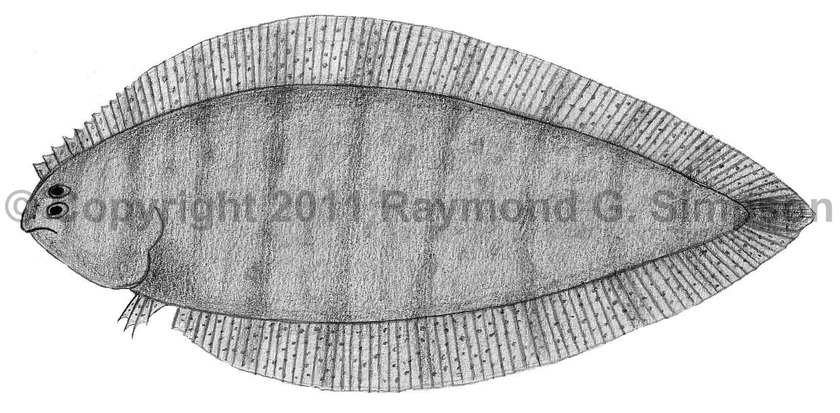
Common Name
Deepwater Tonguefish
Year Described
Goode and Bean, 1886
Identification
Dorsal Fin Rays: 80-90
Anal Fin Rays: 68-74
Pectoral Fin Rays: none
Pelvic Fin Rays: 4
Caudal Fin Rays: 12
Longitudinal Scale Rows: 62-75
Vertebrae: 45-49
Pterygiophore pattern (1st three interneural spaces): 1-3-2
Other diagnostic characters include: pupillary operculum absent, teeth usually present on 3/4 of ocular side premaxilla (sometimes entire premaxilla), entire dentary toothed, ocular side lower jaw without fleshy ridge, scales absent on blind side dorsal and anal fins, and 5 hypurals.
Color
Dark brown with 3-10 narrow crossbands of varying intensity (depending on substrate), continuing onto dorsal and anal fins as blotches. Peritoneum black. Dorsal and anal fins without obvious spots. Caudal fin uniformly dark. Blind side pale without melanophores.
Size
Adults from 70-105mm. Maximum size is 130mm.
Habitat
Outer continental shelf and upper slope from 92-549m (usually 141-300m), over mud bottoms.
Range Map

Range
Scattered records throughout the Caribbean Sea, Gulf of Mexico, off the SE U.S., and off NE South America.
References
Munroe, T.A. 1998. Systematics and ecology of western Atlantic tonguefishes (Symphurus: Cynoglossidae: Pleuronectiformes). Fish. Bull. 96(1):1-182.
Munroe, T. A. 2003. Bothidae (Pp. 1885-1895), Scophthalmidae (Pp. 1896-1897), Paralichthyidae (Pp. 1898-1921), Poecilopsettidae (Pp. 1922-1923), Achiridae (Pp. 1925-1933), Cynoglossidae (Pp. 1934-1959). In: Carpenter. 2003. The living marine resources of the Western Central Atlantic v. 3.